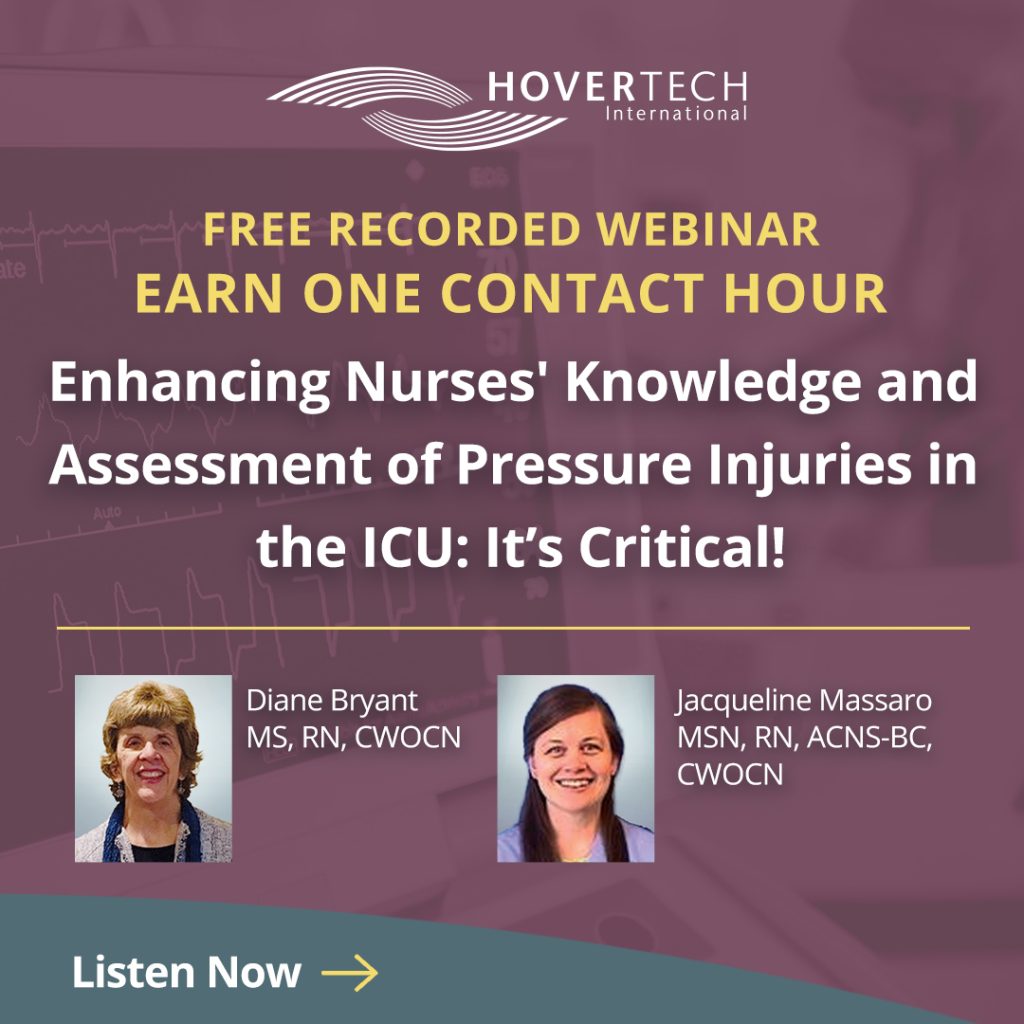ICU Pressure Injuries: Unique Risk Factors and Skin Assessment Tips
Listen to the Supplementary, Free Webinar on ICU Pressure Injuries
Pressure injuries in critical care settings are common, clinically catastrophic, and costly. Read on for helpful prevention guidelines and listen to our on-demand webinar to earn one contact hour.
When acute illness and underlying conditions combine, the likelihood of pressure injuries skyrockets. As a result, more than 14% of ICU patients experience pressure injuries, also known as pressure ulcers. This is problematic for several reasons:
First and foremost, pressure injuries are painful, prone to infection, slow to heal, and can lead to death. An astounding 60,000 patients die each year as a result.
Then there’s the fiscal cost. When they develop in clinical settings, pressure injuries become known as hospital-acquired pressure injuries (HAPI for short). HAPI are the financial responsibility of the healthcare system, costing anywhere from $500 to $70,000 each – sometimes more.
Which leads to the matter of liability. Seventeen thousand lawsuits each year revolve around pressure injuries. Though most experts agree that pressure injuries develop as the result of both intrinsic (genetic and physiological) and extrinsic (external) factors, they are often equated with poor nursing care. This is all the more reason nurses and other clinicians need to go the extra mile not only to prevent HAPI, but to check for and document any presence of pressure injuries upon patient admission.
Below we outline four pressure injury risk factors common among critically ill patients – and practices for allaying them. These practices have been shown to reduce incidence of pressure injuries in clinical care settings.
Risk Factors for Pressure Injuries in Critical Care
Critical care settings increase the risk of pressure injuries for several reasons. Chief among them:

Immobility
The prevalence of immobility is a key reason pressure injuries commonly develop in critical care units. However, this risk can be defused. Beyond standard repositioning every two hours or less, carefully consider the support surface beneath your immobile patient. Customize settings to achieve the highest degree of pressure redistribution possible. On top of standard repositioning, consider microshifts – small, more frequent changes in position, which are especially valuable for patients who cannot tolerate turning or larger moves. Microshifts can be as simple as slightly moving a limb. The average person moves every ten minutes when sleeping; try to replicate this for patients who might not be doing it on their own.
Medical devices
The ICU is teeming with diagnostic and therapeutic medical devices that can cause pressure ulcers at contact points. Cervical collars, tubing devices, splints, and intravenous catheters are particularly detrimental to skin health. To offset risk, review tips from the National Pressure Injury Advisory Board. These tips include resizing devices to better fit the patient, cushioning high-risk areas where there are fewer layers of skin and tissue (the nasal bridge, for example), and inspecting skin under and around the device and related dressings once a shift at minimum, unless contraindicated.
Diabetes
Diabetes causes microvascular changes caregivers can’t control, which have the potential to increase the risk of pressure injury development. Patients with diabetes warrant more vigilant assessment.
Vasopressors
Vasopressors induce vasoconstriction in peripheral blood vessels. This can cause hypoperfusion (reduced blood flow) that increases the likelihood of pressure injuries. Even if there is no change in skin color, if patients’ hands and/or toes feel cooler to the touch, be on alert: They’re at a heightened risk for pressure injuries. Be sure to document in your notes that the patient is exhibiting signs of hypoperfusion peripherally. Such documentation can help demonstrate that due to the hypoperfused state, pressure injuries were not preventable despite best efforts.
Best Practices for Assessing Skin of Critical Care Patients
Vigilant skin inspection is the best defense against the risks outlined above. Note that pressure injuries present most often on the sacrum and coccyx, buttocks, and heels. Check every nook and cranny is a good rule of thumb. High inspection frequency is similarly key. Beyond coloring, assess skin’s moisture, firmness, and temperature.
Do this at the top of every shift, when conditions change, after lengthy procedures, and of course at all scheduled assessment times. Don’t assume that a patient is at less risk if they’re ambulatory. Walking with a balloon pump or extracorporeal membrane oxygenation (ECMO) machine means the patient is in a critical state; they are mobile, yes, but still very much in the woods.
Here are three ways to elevate assessment habits and better prevent against pressure injury progression or HAPI development:

Four Eyes
Four Eyes is a collaborative method in which two nurses complete head-to-toe skin assessment together. This approach has been shown to improve early identification of pressure injuries present on patient admission.
Good Light
Be sure to fully illuminate a clinical care setting via lights and daylight (if available) before performing a skin assessment. Use a handheld flashlight or smartphone flashlight to complement existing light if needed. Flashlights are especially helpful for checking beneath thick hair for signs of pressure ulcers on the head . Mirrors are helpful for inspecting areas of the body that can be hard to see, like heels.
Routinely Look Under Medical Devices
If a patient is connected to medical devices, visual inspection can be tough. Don’t let this deter your team from a thorough inspection. Even if it requires two or three caretakers, take the time and use the tips and methods above to inspect the entire body, and especially skin beneath and around medical device pressure points.
Did you find this blog helpful? Send it to a fellow RN. Earn one contact hour, and listen to the full on-demand webinar about ICU pressure injuries presented by Diane Bryant MS, RN, CWOCN & Jacqueline Massaro MSN, RN, ACNS-BC, CWOCN.
For more information on safe patient handling tools that help prevent pressure injuries, contact HoverTech International.

